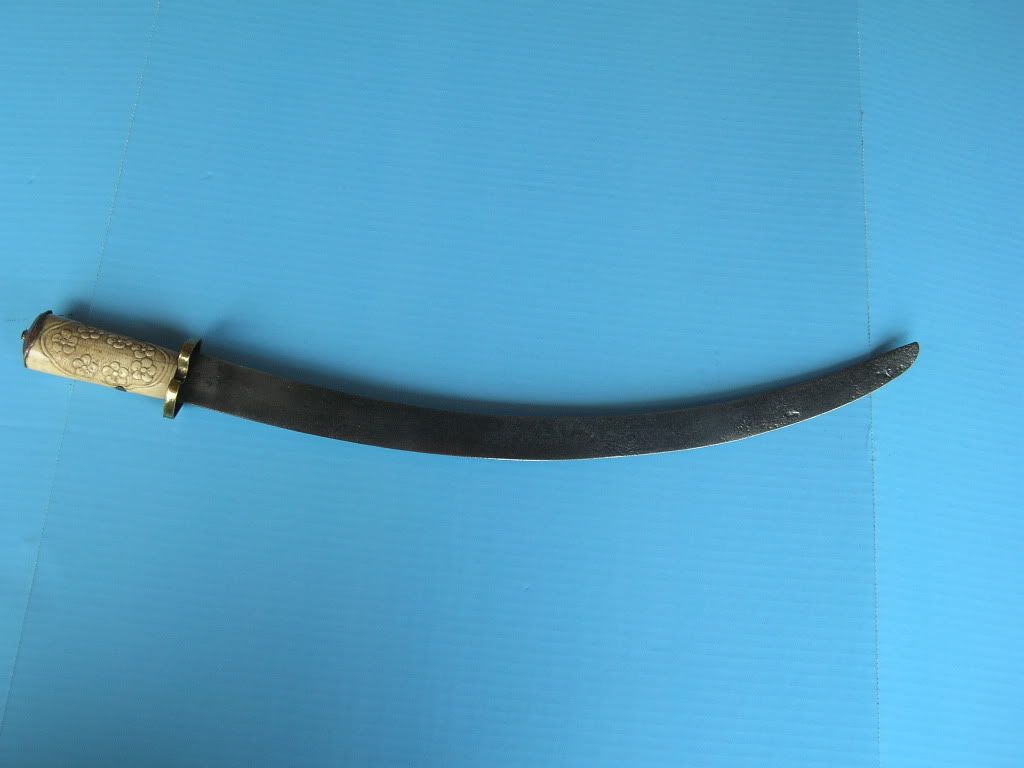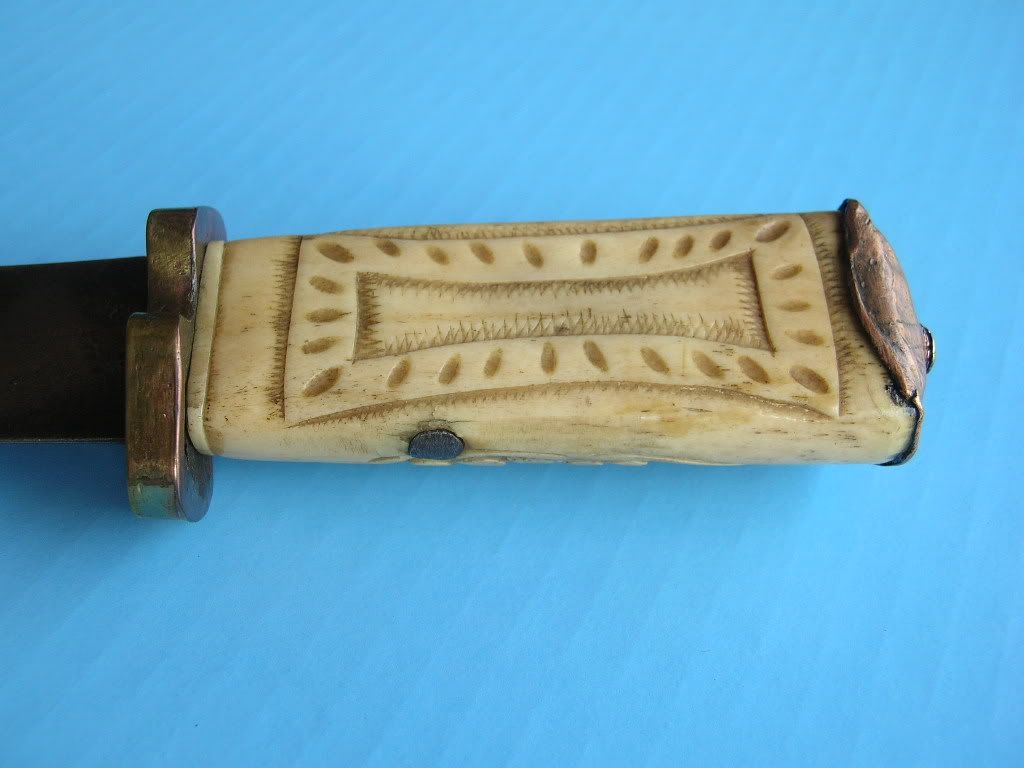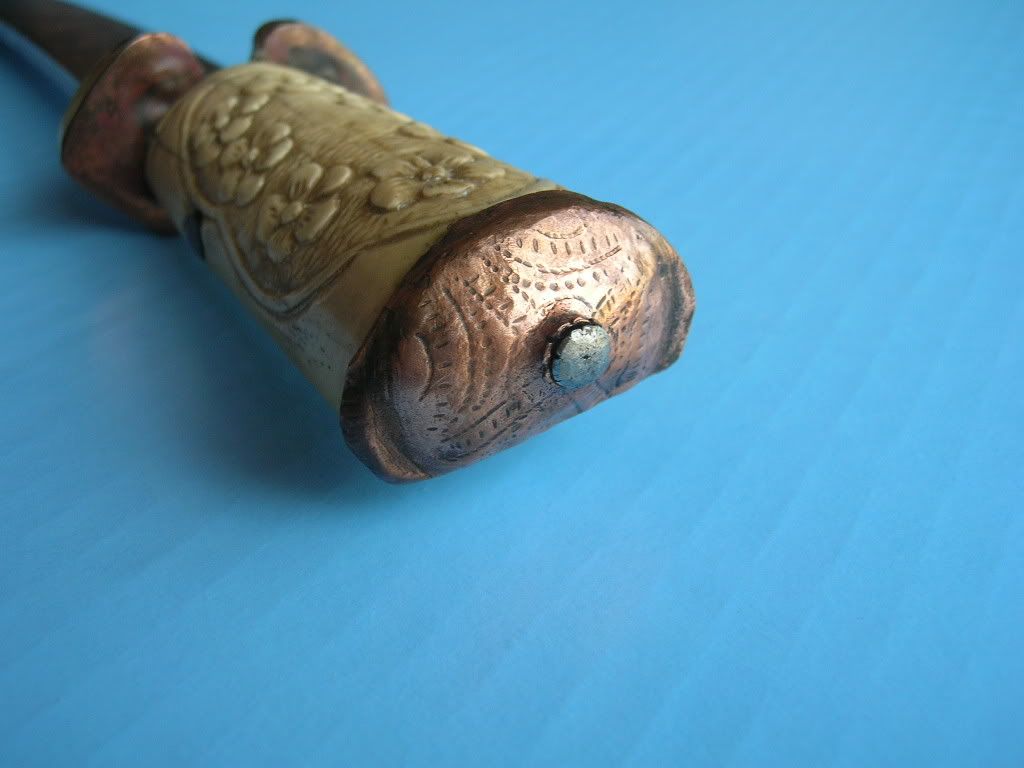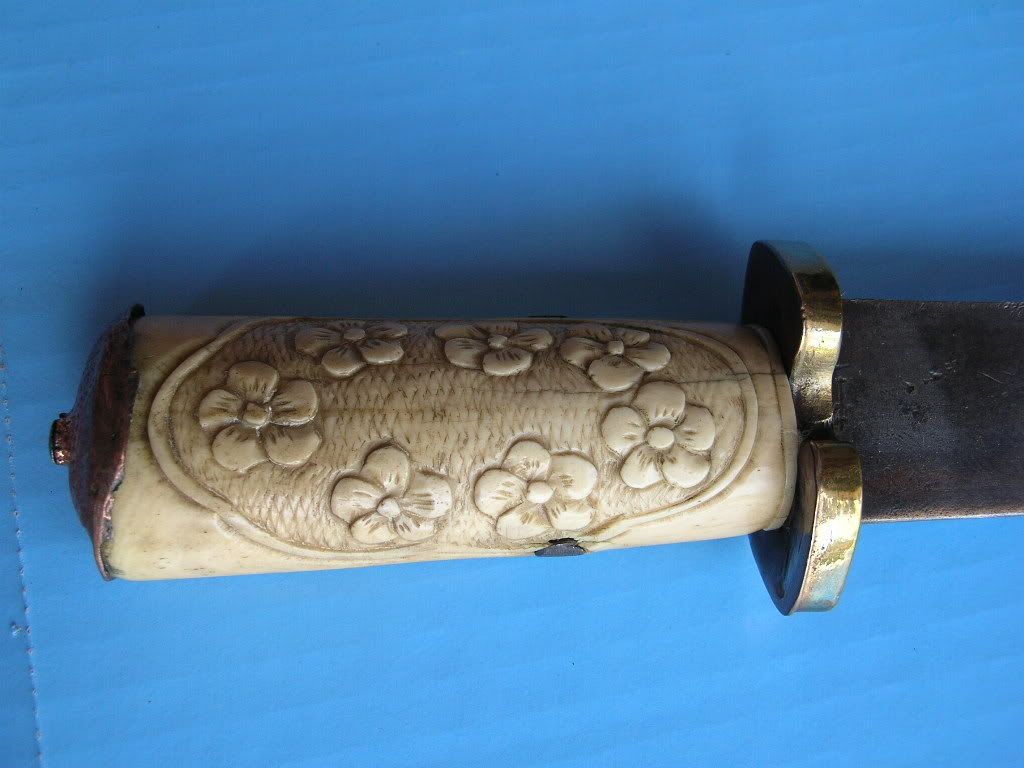
 |
|
|
#1 |
|
Member
Join Date: Dec 2004
Location: NC, U.S.A.
Posts: 2,076
|
http://cgi.ebay.com/ws/eBayISAPI.dll...MEWA%3AIT&rd=1
Ignore this link! Last edited by M ELEY; 3rd June 2005 at 02:24 AM. Reason: Bad link |
|
|

|
|
|
#2 |
|
Member
Join Date: Dec 2004
Location: NC, U.S.A.
Posts: 2,076
|
Oh well...couldn't get it to pull up that way. I just won this sword and was seeking the opinions of the folks here. It's eBay item # 653366647. I just received it in the mail and am curious as to its origin. In my own opinion, I think this could be American, post-Rev War. It is similar in pattern to the so-called "figure 8" hilted swords of the 1780-1810 period. Its corrigated hilt indicates post 1800 date. It is similar to the British M1845 patterns, but I'm convinced it predates them. Its blade is only sharp at the end, is strangely/sharply curved, making it different from most British patterns, and has a wedge-shaped non-fullered blade. The hilt is not the typical patterns of anything I've seen. You'll note that the blade was strengthened by a brazing of brass where the blade and cup-guard meet. This brass has patina to it, indicating that the sword was either originally made this way, or its an old repair during its working life. My question is, did American naval swords of the Federalist period/war of 1812 have swords like this? Could this be colonial Spain? The brazing-is this seen on American swords of this period. I've seen ones in Neumann's that were strengthened with lead. I know many naval swords of this period were "private purchase", but as I understand it, didn't most British/European swords of this period still follow a typical pattern unlike this? This would have definately been non-regulation. Did most naval swords of this period have unfullered blades, or is this more of a tendency of American/colonial swords? Thanks all!
|
|
|

|
|
|
#3 |
|
Member
Join Date: Dec 2004
Location: B.C. Canada
Posts: 473
|
Is there any way you can post the pictures, I am unable to get any using your links.
Jeff |
|
|

|
|
|
#4 |
|
Member
Join Date: Dec 2004
Location: NC, U.S.A.
Posts: 2,076
|
Let's try this again, as the first link was bad...
http://cgi.ebay.com/ws/eBayISAPI.dll...tem=6533666477 |
|
|

|
|
|
#5 |
|
Member
Join Date: Nov 2004
Location: USA
Posts: 1,725
|
Boy, that blade really does remind me of the sword we discussed on this old thread: http://www.vikingsword.com/ubb/Forum1/HTML/001880.html
The pix are long gone. I'll try to take some tomorrow and post them here for comparison. By the way, it's good to see you posting, Mark. Welcome back. 
|
|
|

|
|
|
#6 |
|
Member
Join Date: Dec 2004
Location: NC, U.S.A.
Posts: 2,076
|
Thanks, Andrew! I still visit the site frequently (with all of this information from such esteemed sources, it would be foolish not to), but don't have much free time to post. Yes, I do remember this particular sword with its sharply curved blade. Well, thats one that didn't occur to me! There is a distinct possibility that this could be a Chinese cutlass. Still, if it weren't for the blade, I'd still assume British or American merchantman. Would like to see pics of that old sword we discussed again, though, for comparison.
|
|
|

|
|
|
#7 |
|
Member
Join Date: Nov 2004
Location: USA
Posts: 1,725
|
The weather is conspiring against taking pix today, maybe tomorrow.
Certainly, the handles are very different. It's the blades that strike me as similar. It may be just the cosmetic appearance from similar pitting and age, but your description of the wedge-shape cross section had me thinking... |
|
|

|
|
|
#8 |
|
Member
Join Date: Dec 2004
Location: NC, U.S.A.
Posts: 2,076
|
The wedged blade does fit, especially with the dau swords. You mentioning this also got me to thinking how much the rounded-bowl guard on mine also resembles many of the Chinese guards, minus the knuckle bow. Hmmm...
|
|
|

|
|
|
#9 |
|
Member
Join Date: Dec 2004
Location: Greensboro, NC
Posts: 1,083
|
This sword has a composite feel to me. In looking closely at the pictures, there are a few things I notice:
1) The blade shape, profile and the way it widens at its tip plus also abruptly swings upwards reminds me most of Tulwar blades. 2) The ribbed grip has a more European flare and seems similar to those on early British naval cutlass. 3) The guard appears to be a much later add on. Notice that it is not peined through at the top and the part of the guard which fits over the blade looks forced on. If all componenets had been assembled at the same time one would expect the top to be peined and a much better and natural fit of the guard over the blade portion. In one of the pictures there seems to be a small remnant of glue or something coming from the area of the guard, blade and handle conjoining. Now, this is not to say that these pieces did not come together a long time ago. Certainly one finds Indian blades mounted up in British hilts. You will be able to tell much better once you have the piece in hand. |
|
|

|
|
|
#10 |
|
Member
Join Date: Dec 2004
Location: NC, U.S.A.
Posts: 2,076
|
Hello,Rick! Sorry I haven't contacted you in ages. I've been exceptionally busy. I promise to drop you an email soon! Now, about this saber-
Ouch! I hope you are wrong on this one, but you're right about it not being peined on the end. The part that looks like glue is the brazed brass I spoke of(I scraped away the new black paint that coverted it). I've heard of some colonial American pieces with hilts being held on with molten lead,brass,etc. The brazing does show some age. You make an excellent point about British era swords being adapted to Indian use and the curve on this blade. Perhaps this was an Indian "capture" from sea use which saw adaptation. The blade is definately old, matching the hilt in pitting/age, but its possible that the guard is a later addition (maybe not too distant of a time period). The hilt is similar to the British/American affairs, with the blackened finish to the hilt. The only thing that still makes me think that the blade could still be European is that it is thick, wedge-shaped, only sharpened near the point down to about 10", definately not watered steel. It is a thick monster, but the pics from eBay are deceiving as it doesn't swell toward the tip (it does make an abrupt curve, though). I've seen some late 18th/early 19th century blades like this. I'm guessing that this will be one of those pieces that will remain a partial mystery. Last edited by M ELEY; 4th June 2005 at 01:38 AM. Reason: Wrong wording! |
|
|

|
|
|
#11 |
|
Member
Join Date: Nov 2004
Location: USA
Posts: 1,725
|
Mark, we finally got some clear weather yesterday, and I took some shots of my sword. I noticed something interesting at the forte, but will start a new thread about that so as not to hijack yours.
    
|
|
|

|
|
|
#12 |
|
Member
Join Date: Dec 2004
Location: Houston, TX, USA
Posts: 1,254
|
That edgewise pin is fairly interesting, too; you didn't really tell us about that before, I think?
Those ebay pics are deceptive; it really looks like a swelled tip. Is the hilt all-metal? What metal? Is it one piece? The hole in the bowl amost looks as if it goes right to the edge of the blade or even of the tang? Commentary? Explanation? Possible driver of the brazing? The way the brass is puffed up so far above the joint suggests it was dropped on/in, whether from a ladel, or a rod; not placed solid then melted in place after the nature of traditional brazing. BTW, I don't neccessarily think it is one (though with the tip not being swelled....), but the wedge section is not unseen on European swords. It is in fact sometimes seen, most notably on hangers. |
|
|

|
|
|
#13 |
|
Member
Join Date: Dec 2004
Location: NC, U.S.A.
Posts: 2,076
|
Andrew, you are right about the similarity in the blades, especially with the pitting (I wonder if yours might not have seen sea service to be pitted in this way- salt air and all. I still believe that mine has a European blade, though...
|
|
|

|
|
|
#14 |
|
Member
Join Date: Dec 2004
Location: NC, U.S.A.
Posts: 2,076
|
Tom, sorry to take so long to get back to this thread. I've been doing research via Gilkerson's book "Borders Away" and Annis' "Naval Swords" and I'm still convinced that my sword is the real deal- that is, a private purchase cutlass for a merchantman ship, possibly ca 1800-20. These swords came in all shapes,sizes. Many were crude, having been repaired in the field, refitted, resharpened, painted with pitch, etc.
Now-about the sword. The iron grip fits the patterns of 1800-20, the rouned dish guard is cruder than the ebay pic lets on (i.e. I doubt its machine-made). The diamond-cut to the hilt does go right uo to the blade edge. The whole hilt construction is odd/unique, as most of these had a separate grip with piened tang where the sheet guard comes into it. This hilt appears to be constructed as a whole, with the grip/guard/bowl all as one piece (the only other possibility is that it,too, is welded with brass, but if it is, it is lost under many layers of old marine pitch/paint of the era). If this is the construction of the hilt(whole), then I suppose that the blade might have been slid in place and brazed with brass to hold it firm. I believe that the blade is European and of the period. Interesting items, these private purchase sea swords...kind of ethnogrphic in their variety! |
|
|

|
|
|
#15 |
|
Member
Join Date: Dec 2004
Location: NC, U.S.A.
Posts: 2,076
|
Tom, I know you know much about construction and smithing of weapons. It does appear that the hilt on this sea sword was slid into a constructed hilt and then brass poured into the socket to secure it. Have you ever heard of this process being done? Time period and/or country of origin? Just read in Annis' book that many sea swords were made from brass, as it doesn't corrode nearly as fast as traditional iron does (the reason so many naval swords were painted with pitch- glad they chose black paint BTW. Can you imagine if some joker decided on pink!), so perhaps that's why this is the reasoning behind the construction of the joint...
|
|
|

|
|
|
#16 |
|
Member
Join Date: Jun 2005
Posts: 210
|
This looks like an 18th century American Sabre. There is an example shown with a very similar blade on plate #269 of Arms and Armour of Colonial America, Harold Peterson. Also, plate #256 has examples with similar hilts.
n2s |
|
|

|
|
|
#17 |
|
Member
Join Date: Dec 2004
Location: NC, U.S.A.
Posts: 2,076
|
Thanks, n2s. That was my feeling as well, but I wasn't too sure. I still don't have Peterson's book...I'll have to check out a copy via library loan. Thanks for responding. BTW, if it truly is American colonial, I'll be quite pleased!!
|
|
|

|
|
|
#18 |
|
Member
Join Date: Dec 2004
Location: Houston, TX, USA
Posts: 1,254
|
The most similar thing I'm familiar with as an affixing method is more usually done with aluminum (modern, of course) or lead/lead alloys. With poured brass into a hollow handle rather than into a mold forming a solid one-piece cast brass handle, it seems unusual. Don't get me wrong; neither do I know everything nor are unusual things unusual
 see if you follow that one see if you follow that one  The general type of the handle, hollow metal, ribbed, etc. is certainly a thing I'd seen, fairly often and in many verieties, but usually with the tang just passed thru and piened. This attachment method should be stronger, and as noted, should help keep the tang from rusting. I'd think the sword is fairly handle-heavy? But the narrow grip and fairly thin bowl may keep things within reason, and even the cut-out may have to do with a balancing concern (pure speculation; such holes are fairly usual, except that this one goes all the way to the tang, and so seems added on or otherwise nonprofessional/unusual in some way)? I'm unclear as to what metal the hilt is made of; is it brass, or iron? I'm right with you on the private issue cutlasses/hangers, the maritime ones often having variously ship-board made hilts, many sharing features in common with Oceaninc East Asian swords (thin sheet metal knuckle guards ala Visayan swords, occasional habiki-like bolsters......), and often partaking of traditional sailors' crafts such as scrimshaw, engraving, knotwork. I often enjoy the quality on Western military/overculture swords, but I really find the folk level plastic art more interesting in general. It is often spoken of as if this did not exist in Europe, as if the overculture/industrial culture WERE European culture; I do not believe this is accurate; there seems to be (to this day, even) a strong strain of peasant/rural/underclass/lowtech culture that is often ignored or looked down upon, but which I find quite interesting and interestingly comparable to other traditional/preindustrial cultures; this is certainly notable of its material culture, including blades, which are more often with a soft body and harder edge (often welded/inlaid), and as I've metioned about hangers, more often of wedge cross section, than military/government/etc. swords. And it's also interesting how it interfaces with foreign material culture through international sailor subculture on the empire of the waves. I find user made/field made dress particularly interesting; sometimes it is of good or even particular quality, and other times I feel compelled to remove it from a good blade and replace it for nonfunctionality.....This one looks perhaps professionally made, but user-affixed? Just a guess. Sounds like it's pretty dang solid, anyway, which is a big good in a sword handle The general type of the handle, hollow metal, ribbed, etc. is certainly a thing I'd seen, fairly often and in many verieties, but usually with the tang just passed thru and piened. This attachment method should be stronger, and as noted, should help keep the tang from rusting. I'd think the sword is fairly handle-heavy? But the narrow grip and fairly thin bowl may keep things within reason, and even the cut-out may have to do with a balancing concern (pure speculation; such holes are fairly usual, except that this one goes all the way to the tang, and so seems added on or otherwise nonprofessional/unusual in some way)? I'm unclear as to what metal the hilt is made of; is it brass, or iron? I'm right with you on the private issue cutlasses/hangers, the maritime ones often having variously ship-board made hilts, many sharing features in common with Oceaninc East Asian swords (thin sheet metal knuckle guards ala Visayan swords, occasional habiki-like bolsters......), and often partaking of traditional sailors' crafts such as scrimshaw, engraving, knotwork. I often enjoy the quality on Western military/overculture swords, but I really find the folk level plastic art more interesting in general. It is often spoken of as if this did not exist in Europe, as if the overculture/industrial culture WERE European culture; I do not believe this is accurate; there seems to be (to this day, even) a strong strain of peasant/rural/underclass/lowtech culture that is often ignored or looked down upon, but which I find quite interesting and interestingly comparable to other traditional/preindustrial cultures; this is certainly notable of its material culture, including blades, which are more often with a soft body and harder edge (often welded/inlaid), and as I've metioned about hangers, more often of wedge cross section, than military/government/etc. swords. And it's also interesting how it interfaces with foreign material culture through international sailor subculture on the empire of the waves. I find user made/field made dress particularly interesting; sometimes it is of good or even particular quality, and other times I feel compelled to remove it from a good blade and replace it for nonfunctionality.....This one looks perhaps professionally made, but user-affixed? Just a guess. Sounds like it's pretty dang solid, anyway, which is a big good in a sword handle 
|
|
|

|
|
|
#19 |
|
Member
Join Date: Dec 2004
Location: NC, U.S.A.
Posts: 2,076
|
I absolutely concur about the subculture of European items(not just swords) and would also add most Western "colonial-types" made in the field. I have been really taken by Spanish colonial pieces ever since I landed a nice Spanish Caribbean sword (or Spanish Moroccan, if Jim wishes to challenge me on this one!!LOL
 , as these pieces truly fit into the ethnographic catagory by their very unique construction, artistic lisence and folk-artsy appeal. The handle on this sword is rather heavy, but balances fairly well I think with its relatively light sheet metal hilt. I hate to ask a really stupid question, but how does one tell if the hilt is brass or iron if it is covered in black-pitch paint? I would hate to scrape off any of the finish, as this is one of the few pieces of evidence that shows that it was made all together in antiquity (not a piece-meal sword!). Is there a test one can do with a magnet or something? (yes, I'm stupid when it comes to alloys!). , as these pieces truly fit into the ethnographic catagory by their very unique construction, artistic lisence and folk-artsy appeal. The handle on this sword is rather heavy, but balances fairly well I think with its relatively light sheet metal hilt. I hate to ask a really stupid question, but how does one tell if the hilt is brass or iron if it is covered in black-pitch paint? I would hate to scrape off any of the finish, as this is one of the few pieces of evidence that shows that it was made all together in antiquity (not a piece-meal sword!). Is there a test one can do with a magnet or something? (yes, I'm stupid when it comes to alloys!).
|
|
|

|
 |
|
|